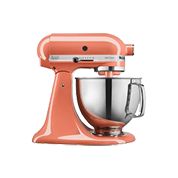Generator Usage with Appliances
Using a Generator with KitchenAid Appliances
Understanding how to safely and efficiently use a generator with your appliances is crucial. This article will guide you through the essentials of running appliances with a generator, including the types of appliances that can be powered, their specific power needs, and how to prevent electrical overload. Additionally, we'll offer safety tips to protect both your appliances and yourself while using a generator.
What Appliances Can I Run With My Generator?
Not all appliances have the same power requirements, so it's important to know each one's wattage needs before using a generator. The best place to look for this information is the model/serial tag, which lists amps, volts, wattage, or a combination of the three. It's essential to consider both the running wattage and the starting wattage, as some appliances need an extra surge of power to start.
Using a generator to power high-wattage appliances can be very useful during power outages or in remote locations. However, it’s vital to ensure your generator can handle the load. Generators have various power capacities, usually measured in watts. Choosing a generator that can provide sufficient wattage for your appliances is key.
When using a generator with appliances, always follow safety guidelines and ensure proper installation. Consult the generator’s manual and adhere to specific instructions provided by the manufacturer.
Appliance Power Needs
Understanding your appliance power needs is crucial for optimal performance and efficiency when using a generator. Here are some key factors to consider:
Calculating the total wattage required for all appliances: Before connecting your appliances to a generator, determine their total wattage. This information can usually be found on appliance labels or in user manuals. Add up the wattage of all the appliances you intend to power simultaneously to ensure your generator can handle the load. Depending on the motor's efficiency, it may require two to three times the running amps to start. On refrigeration, for example, we recommend doubling the running wattage for motor start-up consideration. This surge of power lasts only for a few seconds but must be considered when purchasing a generator.
Prioritizing essential appliances during power outages: During power outages, prioritize your appliances based on their importance. Identify the appliances necessary for your basic needs, such as refrigerators, freezers, and medical equipment. By focusing on these essential appliances, you can optimize your generator’s power usage and ensure you have the necessary resources during emergencies.
Optimizing power usage to extend generator runtime: To maximize your generator’s runtime, optimize power usage. Use energy-efficient appliances to conserve energy, such as turning off unnecessary lights and appliances. Reducing overall power demand extends the runtime of your generator and maximizes efficiency.
By understanding your appliance power needs, prioritizing essential appliances during power outages, and optimizing power usage, you can ensure a seamless experience when using a generator with your appliances.
Generator Wattage Guide*** These ratings are ESTIMATES and should only be used as a rough guide. Confirm the actual power requirements of each item by looking at the information panel on that appliance. This is calculated by multiplying the amps by the volts*** |
|||
|
Appliance |
Running Watts |
Appliance |
Running Watts |
|
Air conditioner (10 BTU) |
1200 |
Dehumidifier |
700 |
|
Clothes Dryer (Electric) |
5800 |
Clothes Dryer (Gas) |
800 |
|
Washing Machine |
1440 |
Refrigerator/freezer |
1000 |
|
Dishwasher |
1400 |
Freezer (Manual) |
500 |
|
Microwave Oven |
800-1100 |
Freezer (self-Defrost) |
1000 |
|
Stove Element |
1500-2400 |
Broiler/Bake Element |
1000-3000 |
Electrical Overload
Electrical overload is a common concern when using a generator to power appliances. It can damage your appliances and pose a safety hazard. To ensure your appliances function properly and avoid electrical overload, it is essential to understand the signs, take preventive measures, and use surge protectors and power strips.
Identifying signs of electrical overload is crucial for preventing potential damage. Common signs include flickering lights, tripped circuit breakers, or appliances not operating at full capacity. If you notice any of these signs, address the issue promptly.
Preventing electrical overload starts with understanding your appliances' power requirements. Each appliance has a specific wattage and amperage rating, which should be considered when calculating the total load on your generator. To prevent overload, avoid connecting appliances that exceed the generator’s capacity.
Using surge protectors and power strips effectively safeguards your appliances from power surges and voltage spikes. These devices help regulate electrical current and prevent damage from sudden power fluctuations. Connect your appliances to surge protectors or power strips for extra protection when using a generator.
Safe Use of Generators
Safety should always be a top priority when using a generator with your appliances. Here are some important considerations:
Proper generator placement and ventilation: Place your generator in a well-ventilated area. Generators produce carbon monoxide, a colorless and odorless gas that can be deadly if inhaled in high concentrations. Ensure your generator is positioned outdoors, away from windows, doors, and vents, to prevent carbon monoxide buildup inside your home.
Understanding generator maintenance and safety precautions: Regular generator maintenance is essential for safe and reliable operation. Follow the manufacturer’s instructions for routine maintenance tasks, such as oil changes, filter replacements, and spark plug inspections. Always turn off the generator and let it cool before refueling—store fuel in approved containers and in a well-ventilated area away from ignition sources.










.png)

























